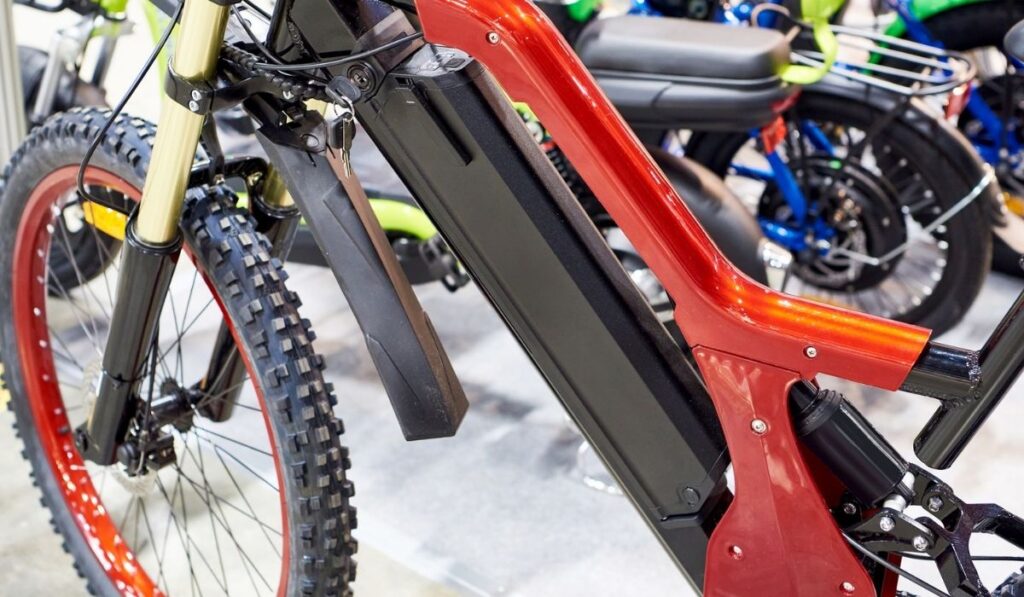The battery is undoubtedly one of the most expensive components of an e-bike. With the high price, you may think you’re better off buying a completely new bike. But if you find yourself needing to buy one, what prices can you expect to pay for a battery? And what do you need to know before you purchase one?
The price of e-bike batteries can range from $250 to well over $500. The price will depend on the brand, quality, and capacity. E-bike batteries can be expensive due to the production costs of lithium-ion, as well as the recent spike in e-bike popularity. E-bike batteries typically last 2-4 years of regular use.
Buying a replacement battery or spare can be a hefty investment. Doing so has advantages, but you may have to weigh the pros and cons before doing so. So, what should you consider? What about upcycling an old E-Bike battery that still has some umf? Read on for all the necessary information!
What Does a Typical E-Bike Replacement Battery Cost?

Electric bike batteries can be pretty expensive. In some cases, e-bike batteries can be half the price of a complete bike! Typically, e-bike batteries range from $250 to over $500. The price of a replacement e-bike battery will depend on the brand, quality, power, and in some cases, the type. Like most things, name-brand batteries are going to be significantly more expensive than lesser-known options.
On Amazon, you can find many batteries for under $300. For example, this 48V battery (on Amazon) by Unit Pack Power is priced fairly. You can also find replacement batteries that come with racks on Amazon. This option by Joyisi (on Amazon) is a good example. You’re paying a little extra for the rack, but if you need this utility, it’s a good deal.
Another factor that can affect the cost is if you go directly through the manufacturer of your bike. For instance, a replacement battery for a Rad Power Bike direct from their website will cost you a little over $500.
So, the price of batteries can vary quite a bit. But if you do a bit of research, you’re bound to find options well within your budget. Just make sure to check that the parts are compatible with your bike before purchasing!
For some riders, the price might be well worth it not just to replace an older battery at end of life, but, as we’ve explored in other articles, some riders are interested in adding a second backup battery to their bike or replacing their existing battery with a bigger one in the pursuit of higher range.
Why Are E-Bike Batteries So Expensive?
Some of the reasons electric bike batteries are expensive are because of the spike in e-bike popularity, the global increase of battery use, and lithium-ion batteries being a costly material option.
E-bikes are gaining popularity at a tremendous rate. In the U.S., electric bike sales rose by 145% in 2020. This rise in demand, with similar levels of production, will inevitably cause prices to skyrocket.
Not to mention, batteries and tech, in general, can be pretty expensive. Globally, more and more people are using batteries. By 2027, the global battery market price to expected to be more than twice what it is now, at $279 billion.
Whether they’re lithium-ion or not, batteries have become a necessary component of technology. The necessity means producers and manufacturers can, and of course, will charge a higher rate.
On top of all that, lithium-ion batteries are going to be more expensive than other options. Most electric bikes use batteries composed of lithium-ion cells. The metals used in these battery packs are finite sources.
Lithium, nickel, manganese, and cobalt all have limited availability. This causes the price to increase at every step of the process.
How Long do E-Bike Batteries Last?
The lifespan of an electric bike battery will vary depending on different factors. Most riders can typically expect 2 to 4 years of life from their e-bike battery.
Charge Cycles
One of the factors that impact the lifespan of an e-bike battery is how many charge cycles it has and how many have been used. One complete charge cycle is used when a battery is full-charged, fully discharged, and fully charged again.
The fewer charge cycles a battery has, the lower performance you will receive, and the closer the battery will be to its eventual death. Most e-bike batteries have a range of between 500 to 1,200 charge cycles.
Maintenance
Another factor that affects the lifespan of an e-bike battery is how well it’s been maintained. Obviously, anything that has been treated with proper care will typically last longer. E-bike batteries are no different. Properly charging, storing, and maintenance of your e-bike battery will extend its lifespan.
Age
Electric bike batteries also deteriorate with age. The longer you use a battery, the less efficient it will become. Lithium batteries will lose capacity over time, even when not in use. This loss of capacity, and use of charge cycles, will reduce the performance of your battery over time.
Two to four years is a general guide, but your mileage may vary. Some riders have reported replacing their batteries yearly or every year and a half. Your e-bike battery life span will be determined by how well you maintain it, properly charge it, and how you ride your e-bike.
Are There Different Types of E-Bike Batteries?

Different types of e-bike batteries available are lithium-ion, nickel, and lead. Each battery type has its own unique set of pros and cons.
Lithium-ion: Lithium-ion batteries are the typical type for e-bikes. They have the highest charge cycle range of 1,000 full charges. These batteries are the standard for today’s market but can be pretty expensive compared to the other options.
Nickel: Nickel batteries have a lower lifespan than lithium-ion batteries at 500 charge cycles. Nickel batteries are gradually becoming a thing of the past; however, if you can find them, they can be a good option. The NiMH variety of nickel batteries is definitely worth looking into for those who are going the DIY route.
Lead: You will be hard-pressed to find an e-bike in today’s market that uses a lead battery. These batteries are cheap and far less efficient, lasting only 300 charge cycles. If you are serious about using your e-bike, do not go with a dead battery.
When Should You Replace Your E-Bike Battery?
A good rule of thumb is to replace your e-bike battery every two years or when you notice a significant decrease in performance. If you’ve had your e-bike for long enough, you should be able to easily detect a reduction in its performance over time.
You’ll notice performance issues from a dying battery. You may need to charge it more frequently and get less range out of it than you did before. You can also get an opinion from your local bike shop to see where your e-bike battery stands.
Can You Still Ride the Bike Without a Battery?
Yes, you can ride an electric bike without a battery. However, the motor will not provide assistance, and doing so is not recommended.
Electric bikes are bicycles, after all. If it has pedals, you can always ride it without the assistance of the motor or battery. However, e-bikes are much heavier than traditional bicycles.
Pedaling a 35lb to 65lb bike after work without any power assistance will not be an enjoyable experience for you. This is why it’s crucial to extend your bike’s battery life and increase its performance.
Extending Your E-Bike’s Battery Life and Performance
Electric bike batteries are expensive, to say the least. Because of this, every rider should try to get the most out of their purchase. Getting the longest lifespan and best performance out of your battery depends on how you ride, charge, and maintain it.
With New Batteries
When you purchase a new electric bike or e-bike battery, you’ll want to fully charge it before riding. Local shops may do this for you, but ask just to be sure. If you order online, your bike/battery may come charged at 30% to 50% capacity. Be sure to fully charge it regardless before riding.
You should also fully charge your new bike/battery for the first five charge cycles. This is to balance out your battery and ensure proper performance. These first five charge cycles may take some time, so be patient and do your due diligence.
After The First 5 Charges
After the first five complete charge cycles, you should charge your battery to around 80-90% capacity. After that, you should occasionally fully charge it 2-3 days in a row. Do these full-charge routines around every 30 charge cycles.
- Never leave a battery charging unattended.
- Never charge your battery after a ride; give it a few hours to cool down.
- Try and charge to 80% and discharge until 20%. Doing so will provide you with the best battery life.
- Don’t leave your battery fully charged at 100% for more than a day.
Riding Techniques:
- Use pedal-assist over the throttle
- Use lower levels of pedal-assist
- Avoid hills and rough terrain
- Coast and cruise as often as possible
- Avoid braking too hard
- Don’t accelerate too fast from a complete stop
Can You Revive an Old E-Bike Battery (Instead of Replacing It?)
Yes, you may be able to revive an old electric bike battery. However, this is best left to professionals.
Since batteries discharge over time, they may just be at low capacity. If specific cells within your battery pack aren’t damaged but have discharged and are at low capacity, it may be possible to revive a battery.
That being said, you will need specific tools to achieve this and the experience as well. Lithium-ion batteries can be dangerous and potentially life-threatening if worked on improperly.

Online casino
Monday 13th of December 2021
I like tthe valuable information you supply in your articles. I'll bookmark your blog and check again here frequently. I'm reasonably sure I'll learn many new stuff right here! Best of luck for the following! https://6172c0D1723Bd.site123.me/